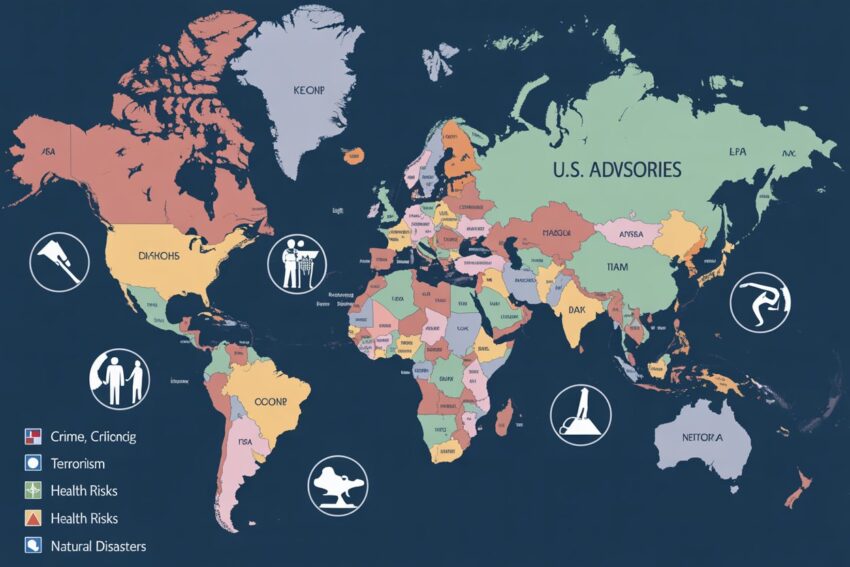U.S. Travel Advisories 2025: Impact on Global Tourism and Safety Measures

As global travel continues to rebound in twenty twenty-five, the U.S. Department of State’s travel advisories play a pivotal role in shaping international tourism. These advisories, updated regularly, provide U.S. citizens with essential information about potential risks in various destinations. Understanding these advisories is crucial for travelers, tourism professionals, and policymakers alike.
Understanding U.S. Travel Advisory Levels
The U.S. Department of State categorizes countries and regions into four advisory levels:
- Level 1: Exercise Normal Precautions
This indicates a low level of risk. Travelers are advised to exercise the same caution they would in their home country. - Level 2: Exercise Increased Caution
There are heightened risks in certain areas. Travelers should be aware of their surroundings and take necessary precautions. - Level 3: Reconsider Travel
Serious risks exist. Travelers are urged to reconsider their plans and evaluate the necessity of their trip. - Level 4: Do Not Travel
The highest level of risk. U.S. citizens are strongly discouraged from traveling to these areas due to potential threats to safety.
These levels are determined based on factors such as crime, terrorism, civil unrest, health concerns, and natural disasters.
Impact on Global Tourism
Destinations with Elevated Advisories
Several popular tourist destinations have received higher-level advisories in twenty twenty-five:
- Mexico: Parts of Mexico, including certain states, have been assigned a Level 2 advisory due to crime and kidnapping risks. Areas like Mexico City and Quintana Roo require travelers to exercise increased caution.
- Egypt: The Northern and Middle Sinai Peninsula, along with the Western Desert, are under a Level 2 advisory due to terrorism and safety concerns. Travelers are advised to avoid these regions unless traveling with a licensed tour company.
- Colombia: Certain regions in Colombia have a Level 2 advisory due to crime and civil unrest. Travelers are encouraged to stay informed about the local situation.
- Peru: A Level 2 advisory is in place for Peru, with concerns over crime, civil unrest, and the risk of kidnapping.
- Costa Rica: Although generally safe, Costa Rica has a Level 2 advisory due to health risks such as rip currents and volcanic activity.
- Antarctica: Due to its extreme environment and limited infrastructure, Antarctica is under a Level 2 advisory. Travelers are urged to prepare for harsh conditions and potential medical emergencies.
Destinations with Lower Advisories
Conversely, some destinations have maintained lower advisory levels:
- Japan: Assigned a Level 1 advisory, Japan remains a safe destination with minimal risks. Travelers are advised to exercise normal precautions.
- Spain: Also under a Level 1 advisory, Spain is considered safe for travel, though visitors should be aware of common petty crimes in tourist areas.
- France: Maintains a Level 1 advisory, with occasional demonstrations and strikes. Travelers should stay alert in crowded areas.
- Portugal: Retains a Level 1 advisory, known for its safety and welcoming atmosphere.
Economic Implications for Tourism
U.S. travel advisories significantly influence tourism economies. Countries with higher advisory levels often experience a decline in U.S. visitors, impacting local businesses and industries reliant on tourism. Conversely, destinations with lower advisory levels may see an increase in U.S. travelers, boosting their tourism sector.
For instance, Mexico’s popular tourist destinations like Cancun and Playa del Carmen have faced challenges due to elevated advisories, leading to decreased bookings and economic strain on local businesses.
Strategies for Travelers
To navigate the complexities of travel advisories, travelers should:
- Stay Informed: Regularly check the U.S. Department of State’s travel advisory website for the latest updates.
- Enroll in STEP: The Smart Traveler Enrollment Program allows travelers to receive timely information from U.S. embassies and consulates.
- Consult Local Authorities: Upon arrival, engage with local authorities and tourism offices to stay updated on the current situation.
- Exercise Caution: In areas with higher advisory levels, remain vigilant, avoid risky areas, and follow local guidance.
In Shot POV
U.S. travel advisories serve as a critical resource for ensuring the safety of American travelers abroad. By understanding these advisories and their implications, travelers can make informed decisions, and tourism professionals can better prepare for the challenges and opportunities that arise from them.
The post U.S. Travel Advisories 2025: Impact on Global Tourism and Safety Measures appeared first on Travel And Tour World.